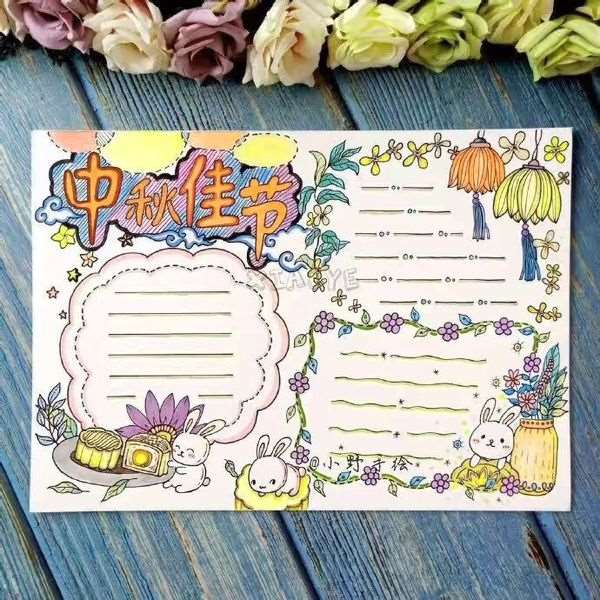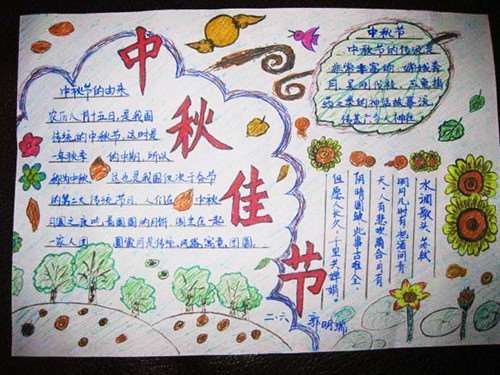中秋节手抄报简单漂亮
曲谱自学网今天精心准备的是《中秋节手抄报简单漂亮》,下面是详解!
中秋节手抄报英文内容
"Zhong Qiu Jie", which is also known as the Mid-Autumn Festival, is celebrated on the 15th day of the 8th month of the lunar calendar. It is a time for family members and loved ones to congregate and enjoy the full moon - an auspicious symbol of abundance, harmony and luck. Adults will usually indulge in fragrant mooncakes of many varieties with a good cup of piping hot Chinese tea, while the little ones run around with their brightly-lit lanterns.
农历八月十五日是中国的传统节日——中秋节。在这天,每个家庭都团聚在一起,一家人共同观赏象征丰裕、和谐和幸运的圆月。此时,大人们吃着美味的月饼,品着热腾腾的香茗,而孩子们则在一旁拉着兔子灯尽情玩耍。
"Zhong Qiu Jie" probably began as a harvest festival. The festival was later given a mythological flavour with legends of Chang-E, the beautiful lady in the moon.
中秋节最早可能是一个庆祝丰收的节日。后来,月宫里美丽的仙女嫦娥的神话故事赋予了它神话色彩。
According to Chinese mythology, the earth once had 10 suns circling over it. One day, all 10 suns appeared together, scorching the earth with their heat. The earth was saved when a strong archer, Hou Yi, succeeded in shooting down 9 of the suns. Yi stole the elixir of life to save the people from his tyrannical rule, but his wife, Chang-E drank it. Thus started the legend of the lady in the moon to whom young Chinese girls would pray at the Mid-Autumn Festival.
传说古时候,天空曾有10个太阳。一天,这10个太阳同时出现,酷热难挡。弓箭手后翌射下了其中9个太阳,拯救了地球上的生灵。他偷了长生不死药,却被妻子嫦娥偷偷喝下。此后,每年中秋月圆之时,少女们都要向月宫仙女嫦娥祈福的传说便流传开来。
In the 14th century, the eating of mooncakes at "Zhong Qiu Jie" was given a new significance. The story goes that when Zhu Yuan Zhang was plotting to overthrow the Yuan Dynasty started by the Mongolians, the rebels hid their messages in the Mid-Autumn mooncakes. Zhong Qiu Jie is hence also a commemoration of the overthrow of the Mongolians by the Han people.
在14世纪,中秋节吃月饼又被赋予了一层特殊的含义。传说在朱元璋带兵起义推翻元朝时,将士们曾把联络信藏在月饼里。因此,中秋节后来也成为汉人推翻蒙古人统治的纪念日。 字串7
During the Yuan Dynasty (A.D.1206-1368) China was ruled by the Mongolian people. Leaders from the preceding Sung Dynasty (A.D.960-1279) were unhappy at submitting to foreign rule, and set how to coordinate the rebellion without it being discovered. The leaders of the rebellion, knowing that the Moon Festival was drawing near, ordered the making of special cakes. Packed into each mooncake was a message with the outline of the attack. On the night of the Moon Festival, the rebels successfully attacked and overthrew the government. What followed was the establishment of the Ming Dynasty (A.D. 1368-1644). Today, moon cakes are eaten to commemorate this event.
在元朝,蒙古人统治中国。前朝统治者们不甘心政权落入外族之手,于是密谋策划联合起义。正值中秋将近,起义首领就命令部下制作一种特别的月饼,把起义计划藏在每个月饼里。到中秋那天,起义军获取胜利,推翻了元朝,建立明朝。今天,人们吃月饼纪念此事。
Mid-Autumn Day 中秋节
Mid-Autumn Day is a traditional festival in China. Almost everyone likes to eat mooncakes on that day. Most families have a dinner together to celebrate the festival. A saying goes, "The moon in your hometown is almost always the brightest and roundest". Many people who live far away from homes want to go back to have a family reunion. How happy it is to enjoy the moon cakes while watching the full moon with your family members.
或:中秋节英文手抄报内容
The joyous Mid-Autumn Festival was celebrated on the fifteenth day of the eighth moon, around the time of the autumn equinox(秋分). Many referred to it simply as the "Fifteenth of the Eighth Moon".
在欢乐的中秋节是庆祝第八届月球15天,周围的秋分时间(秋分)。许多人说只是简单的“第八届第十五次月亮”。
This day was also considered as a harvest festival since fruits, vegetables and grain had been harvested by this time and food was abundant. Food offerings were placed on an altar set up in the courtyard. Apples, pears, peaches, grapes, pomegranates(石榴), melons, oranges and pomelos(柚子) might be seen. Special foods for the festival included moon cakes, cooked taro(芋头)and water caltrope(菱角), a type of water chestnut resembling black buffalo horns. Some people insisted that cooked taro be included because at the time of creation, taro was the first food discovered at night in the moonlight. Of all these foods, it could not be omitted from the Mid-Autumn Festival.
这一天也被认为是因为水果,蔬菜和粮食是由这个时间和粮食收获是丰富的丰年祭。食品产品被放在院子里订了一个祭坛。苹果,梨,桃,葡萄,石榴(石榴),甜瓜,橘子和文旦(柚子)可能会被视为。电影节的特别食品,包括月饼,
煮熟的芋头(芋头)和水caltrope(菱角),一个马蹄型水牛类似黑角。有些人坚持认为,煮熟的芋头,因为在设定的时间内,芋头是第一食品在夜间发现了月光。在所有这些食品,但不能忽略中秋节。
The round moon cakes, measuring about three inches in diameter and one and a half inches in thickness, resembled Western fruitcakes in taste and consistency. These cakes were made with melon seeds(西瓜子), lotus seeds(莲籽), almonds(杏仁), minced meats, bean paste, orange peels and lard(猪油). A golden yolk(蛋黄) from a salted duck egg was placed at the center of each cake, and the golden brown crust was decorated with symbols of the festival. Traditionally, thirteen moon cakes were piled in a pyramid to symbolize the thirteen moons of a "complete year," that is, twelve moons plus one intercalary(闰月的) moon. uUlsda E
圆形月饼,直径约3一,厚1英寸,1.5英寸的测量,在味道类似西方的水果蛋糕和一致性。这些蛋糕已经作出瓜子(西瓜子),莲子(莲籽),杏仁(杏仁),切碎的肉,豆沙,陈皮和猪油(猪油)。金色的蛋黄从咸蛋(蛋黄)是放置在每个蛋糕的中心,
和金黄色地壳装饰节的象征。传统上,13个月饼堆放在一个金字塔象征的“完整的卫星今年13”,也就是说,12个卫星加上一个闰(闰月的)月亮。 uUlsda首页
The Mid-Autumn Festival is a traditional festivity for both the Han and minority nationalities. The custom of worshipping the moon can be traced back as far as the ancient Xia and Shang Dynasties (2000 B.C.-1066 B.C.). In the Zhou Dynasty(1066 B.C.-221 B.C.), people hold ceremonies to greet winter and worship the moon whenever the Mid-Autumn Festival sets in. It becomes very prevalent in the Tang Dynasty(618-907 A.D.) that people enjoy and worship the full moon. In the Southern Song Dynasty (1127-1279 A.D.), however, people send round moon cakes to their relatives as gifts in expression of their best wishes of family reunion. When it becomes dark, they look up at the full silver moon or go sightseeing on lakes to celebrate the festival. Since the Ming (1368-1644 A.D. ) and Qing Dynasties (1644-1911A.D.), the custom of Mid-Autumn Festival celebration becomes unprecedented popular. Together with the celebration there appear some special customs in different parts of the country, such as burning incense(熏香), planting Mid-Autumn trees, lighting lanterns on towers and fire dragon dances. However, the custom of playing under the moon is not so popular as it used to be nowadays, but it is not less popular to enjoy the bright silver moon. Whenever the festival sets in, people will look up at the full silver moon, drinking wine to celebrate their happy life or thinking of their relatives and friends far from home, and extending all of their best wishes to them.
在中秋节,是为汉族和少数民族的传统节日。在月亮的崇拜习俗可以追溯到至于古代夏,商时期(公元前2000年,1066年)。在周朝(公元前1066年,公元前221年),人们举行仪式,迎接冬季和崇拜月亮每当中秋节到来之
它变得非常盛行于唐朝(公元618-907年),人们喜欢和崇拜的满月。在南宋(1127-1279年),但是,人们送月饼,以圆他们的亲属在他们最好的家庭团聚的表达民意的礼物。当它变得黑暗,他们查找的全银月球或继续湖泊观光
庆祝节日。自明朝(1368-1644年),清(1644 - 1911A.D。)的中秋习俗中秋节庆祝活动变得前所未有的欢迎。随着庆祝似乎有在不同地区的国家,如烧香(熏香),一些特殊的习俗,种植中秋树木,灯光塔,舞火龙灯。
然而,根据月亮打习惯不是那么受欢迎,因为它曾经是现在,但它不是冷门享受明亮的银色月亮。每当节日套在,人们会查找在全银月亮,喝着酒,庆祝他们的幸福生活,或其亲属和朋友们的想法远离家乡,并延长其最良好的祝愿给他们。
Moon Cakes
There is this story about the moon-cake. during the Yuan dynasty (A.D. 1280-1368) China was ruled by the Mongolian people. Leaders from the preceding Sung dynasty (A.D. 960-1280) were unhappy at submitting to the foreign rule, and set how to coordinate the rebellion without being discovered. The leaders of the rebellion, knowing that the Moon Festival was drawing near, ordered the making of special cakes. Backed into each moon cake was a message with the outline of the attack. On the night of the Moon Festival, the rebels successfully attached and overthrew the government. Today, moon cakes are eaten to commemorate this legend and was called the Moon Cake.
For generations, moon cakes have been made with sweet fillings of nuts, mashed red beans, lotus-seed paste or Chinese dates(枣子), wrapped in a pastry. Sometimes a cooked egg yolk can be found in the middle of the rich tasting dessert. People compare moon cakes to the plum pudding and fruit cakes which are served in the English holiday seasons.
有这对月饼的故事。在元朝(公元1280年至1368年)中国统治蒙古人民。从前面的宋代领导人(公元960-1280)的不满提交给外国统治,并设置如何协调而不被发现的叛乱。叛乱的领袖,知道中秋节临近,
下令特别蛋糕决策。到每个月饼的支持下,曾经是攻击的轮廓信息。论中秋节晚上,叛军成功附加,推翻政府。今天,吃月饼是为了纪念这个传奇人物,被称为月饼。
世世代代,月饼已与坚果甜馅,红豆泥,荷花种子粘贴或(枣子)中的日期,在酥皮包。有时,煮熟的鸡蛋蛋黄中可以找到丰富的美味甜点中。人们比较月饼的葡萄干布丁,水果,以期在担任英语节日蛋糕。
中秋节手抄报一等奖 三年级
要明亮,所以又叫做“月夕”,“八月节”。中秋前夕,人们
中秋节的手抄报怎么画
中秋节肯定要有月亮月饼,嗯,团圆的东西嗯,画个葡萄架了什么的。嗯,摆一桌子水果跟中秋节有关的景啊什么的都可以画在上面,也可以上网上去搜一搜手抄报,中秋节的手抄报。作一作参考,然后画一个属于自己的手抄报。
简单的中秋国庆手抄报
中秋是以团圆为主题,国庆是以爱国为主题。画的画,写的语句一定都要围绕主题。
中秋节手抄报画
太简单了...
太简单了
中秋节要来了,田老师提供给大家一些中秋节的手抄报,希望能对大家有所帮助,并祝大家中秋快乐,海上生明月,天涯共此时!
中秋节手抄报怎么做?
送你几张漂亮的中秋节手抄报模版,照着画就好了,然后再写一些关于中秋的故事,文章等等,看图:
中秋节手抄报都能写什么内容简单一点的内容
手抄报的内容可以写中秋节的由来、和中秋节相关的古诗、中秋节的风俗习惯等。
中秋节的由来:
中秋节始于唐朝初年,盛行于宋朝,至明清时,已成为与春节齐名的中国传统节日之一。其实在我国古代,帝王就有有春天祭日,秋天祭月的礼制。早在《周礼》一书中,已有“中秋”一词的记载。
《八月十五夜月》
【唐】杜甫
满月飞明镜,归心折大刀。
转蓬行地远,攀桂仰天高。
水路疑霜雪,林栖见羽毛。
此时瞻白兔,直欲数秋毫。
中秋节手抄报
过去学校单位都有这样的手抄报专栏,中秋节手抄报在网上开辟了专栏,讲一些中秋节习俗,月饼的来源和东西南北的做法和吃法。
中秋节手抄报
中秋节简介:
中秋节,又称月夕、秋节、仲秋节、八月节、八月会、追月节、玩月节、拜月节、女儿节或团圆节,是流行于中国众多民族与汉字文化圈诸国的传统文化节日,时在农历八月十五;因其恰值三秋之半,故名,也有些地方将中秋节定在八月十六。
中秋节始于唐朝初年,盛行于宋朝,至明清时,已成为与春节齐名的中国主要节日之一。受中华文化的影响,中秋节也是东亚和东南亚一些国家尤其是当地的华人华侨的传统节日。自2008年起中秋节被列为国家法定节假日。2006年5月20日,国务院列入首批国家级非物质文化遗产名录。
中秋节自古便有祭月、赏月、拜月、吃月饼、赏桂花、饮桂花酒、等习俗,流传至今,经久不息。中秋节以月之圆兆人之团圆,为寄托思念故乡,思念亲人之情,祈盼丰收、幸福,成为丰富多彩、弥足珍贵的文化遗产。中秋节与端午节、春节、清明节并称为中国四大传统节日。
中秋节的习俗,简短一点,手抄报哈
跪求了,,,实在不会个啥==、...
跪求了,,,实在不会个啥= =、
一)嫦娥奔月
据说远在四千多年前,有穷国的国王后羿,勇武善射,但生性暴戾,不体恤民间疾苦,弄得民不聊生。后羿想长生不老,从昆仑山找来长生之药,准备择日吞药,此事为嫦娥得知,为体恤子民,免于后羿长期残暴统治,乃先将此药吃下,突然身轻如燕,飘飘然向月宫腾空飞去,后羿发现,以箭射嫦娥,嫦娥进入广寒宫,成了月神,称为“明月之神”或“太阴娘娘”。
(二)推翻元朝
相传,元末,中原人民不甘受其元的残暴统治,爱国之士纷纷奋起抗元,朱洪武的军师刘伯温要属下扮道士到各县卖符,并称:今年天将降灾,要避灾者可于八月十五日悬挂日月旗,旗将藏于大月饼中。到了这天,各地民众都切大月饼,将其中所藏的旗挂起来,起义声势大振,元人大为吃惊,朱洪武就一击成功,结束了元朝的统治。后来,这种日月旗就是“明”旗。另外类似的传说是月饼内藏一条纸,内写“八月十五夜杀鞑子”,大家切月饼时看到这一张纸,就纷纷奋起把鞑子杀了,元朝就被推翻了。
中秋节的习俗有以下几种:
(一)赏月:
中秋节的月亮是特别的皎洁与圆满,具有象征团圆的意义。古代就有许多人想看月亮里的玉兔和吴刚伐木,现代人是欣赏月夜的自然美景。
(二)吃月饼:
吃月饼的习俗有文字记载是始于明代,传说把节庆的食品神奇化,并赋予爱国的意义。
中秋应景的是“月饼”,与端午节吃粽子一样。月饼是庆团圆或是纪念反抗异族的统治。
(三)团圆:
大家吃月饼、赏月、酬谢土地公等习俗,都在祈求人生圆满光辉,家庭团圆幸福,社区平安,表现出月圆人亦圆的理想。
前人有关月亮的诗词:
1.嫦娥
云母屏风烛影深,长河渐落晓星沉;
嫦娥应悔偷灵药,碧海青天夜夜心。
2.月下独酌唐 李白
花间一壶酒,独酌无相亲;
举杯邀明月,对影成三人。
月既不解饮,影徒随我身,
暂伴月将影,行乐须即春。
我歌月徘徊,我舞影零乱;
醒时同交欢,醉时各分散;
永结无情游,相期邈云汉。
中秋节(中国传统节日)

中秋节,又称月夕、秋节、仲秋节、八月节、八月会、追月节、玩月节、拜月节、女儿节或团圆节,是流行于中国众多民族与汉字文化圈诸国的传统文化节日,时在农历八月十五;因其恰值三秋之半,故名,也有些地方将中秋节定在八月十六。 [1-2]
热门曲谱
 刘德华喊话四大天王合体做节目:他们愿意我 彭于晏带违规水果过海关被罚 据台湾媒体报道,彭于晏7月1日返回台北在松山机场过海关的时候,因为不小心带了水果,被海关查获并罚款3000元台币 。有台湾媒体询问机场工作人...[详情]分类:知识库时间:12:37
刘德华喊话四大天王合体做节目:他们愿意我 彭于晏带违规水果过海关被罚 据台湾媒体报道,彭于晏7月1日返回台北在松山机场过海关的时候,因为不小心带了水果,被海关查获并罚款3000元台币 。有台湾媒体询问机场工作人...[详情]分类:知识库时间:12:37 led和节能灯哪个好
led和节能灯哪个好 概括:这道题是贲友颗同学的课后练习题,主要是关于led和节能灯哪个好,指导老师为黎老师。LED节能灯是继紧凑型荧光灯(即普通节能灯...
[详情]分类:知识库时间:14:47 个人所得税税率
个人所得税税率 概括:这道题是蒲值暇同学的课后练习题,主要是关于个人所得税税率,指导老师为阚老师。
题目:个人所得税税率
解:<...[详情]分类:知识库时间:14:51 个税计算方法
个税计算方法 概括:这道题是文缘卣同学的课后练习题,主要是关于个税计算方法,指导老师为惠老师。负所得税制度的意义财税部门出台了给予弱势群...
[详情]分类:知识库时间:14:51 李光洁宣布结婚 彭于晏带违规水果过海关被罚 据台湾媒体报道,彭于晏7月1日返回台北在松山机场过海关的时候,因为不小心带了水果,被海关查获并罚款3000元台币 。有台湾媒体询问机场工作人...[详情]分类:知识库时间:12:37
李光洁宣布结婚 彭于晏带违规水果过海关被罚 据台湾媒体报道,彭于晏7月1日返回台北在松山机场过海关的时候,因为不小心带了水果,被海关查获并罚款3000元台币 。有台湾媒体询问机场工作人...[详情]分类:知识库时间:12:37 什么可以美白牙齿
什么可以美白牙齿 概括:这道题是贡泼俊同学的课后练习题,主要是关于什么可以美白牙齿,指导老师为井老师。冷光美白牙齿顾名思义就是用冷光来美白牙...
[详情]分类:知识库时间:14:58 什么是连带责任
什么是连带责任 概括:这道题是满澄檬同学的课后政治练习题,主要是关于什么是连带责任,指导老师为宦老师。
题目:什么是连带责任
...[详情]分类:知识库时间:14:58 趣头条与江苏卫视达成战略合作 彭于晏带违规水果过海关被罚 据台湾媒体报道,彭于晏7月1日返回台北在松山机场过海关的时候,因为不小心带了水果,被海关查获并罚款3000元台币 。有台湾媒体询问机场工作人...[详情]分类:知识库时间:12:37
趣头条与江苏卫视达成战略合作 彭于晏带违规水果过海关被罚 据台湾媒体报道,彭于晏7月1日返回台北在松山机场过海关的时候,因为不小心带了水果,被海关查获并罚款3000元台币 。有台湾媒体询问机场工作人...[详情]分类:知识库时间:12:37 利率怎么算
利率怎么算 概括:这道题是从纲凑同学的课后练习题,主要是关于利率怎么算,指导老师为殳老师。银行利率表示一定时期内利息量与本金的比率,通...
[详情]分类:知识库时间:14:58 名贵树种
名贵树种 概括:这道题是山翁灿同学的课后练习题,主要是关于名贵树种,指导老师为谈老师。
题目:名贵树种
解: ...[详情]分类:知识库时间:14:56 埃利斯
埃利斯 概括:这道题是苏似涡同学的课后政治练习题,主要是关于埃利斯,指导老师为裴老师。
题目:埃利斯
解: ...[详情]分类:知识库时间:14:54 差异
差异 概括:这道题是巫唐抖同学的课后练习题,主要是关于差异,指导老师为左老师。暂时性差异是由税收法规与会计准则确认时间或计税基础...
[详情]分类:知识库时间:14:53 平衡梁
平衡梁 概括:这道题是浦晓淖同学的课后练习题,主要是关于平衡梁,指导老师为赵老师。平衡梁为吊装机具的重要组成部分,可用于保持被吊设...
[详情]分类:知识库时间:14:54 建筑图集
建筑图集 概括:这道题是蓟侠位同学的课后政治练习题,主要是关于建筑图集,指导老师为焦老师。《新疆传统建筑图集》是2009年新疆科学技术出...
[详情]分类:知识库时间:14:54 成分分析
成分分析 概括:这道题是颜仑徽同学的课后练习题,主要是关于成分分析,指导老师为戈老师。
题目:成分分析
解: ...[详情]分类:知识库时间:14:56 无坚不摧之力
无坚不摧之力 概括:这道题是路婆掖同学的课后政治练习题,主要是关于无坚不摧之力,指导老师为祁老师。
题目:无坚不摧之力
解:<...[详情]分类:知识库时间:14:54 气垫船原理
气垫船原理 概括:这道题是席洞朴同学的课后练习题,主要是关于气垫船原理,指导老师为毛老师。通风工程是送风、排风、除尘、气力输送以及防、...
[详情]分类:知识库时间:14:54 海狸
海狸 概括:这道题是项筛卦同学的课后练习题,主要是关于海狸,指导老师为钱老师。
题目:海狸
解: ...[详情]分类:知识库时间:14:56 38译码器
38译码器 知识点:《38译码器》 收集:瞿收霉 编辑:桂花
[详情]分类:知识库时间:10:57
本知识点包括:1、38译码器在单片机系统中的作用是什么? 2、求vh... aidma
aidma 知识点:《aidma》 收集:蒯超峦 编辑:栀子花女孩
[详情]分类:知识库时间:12:08
本知识点包括:1、SOV/SOM是什么?AIDMA和AIDAS理论代表什么...




